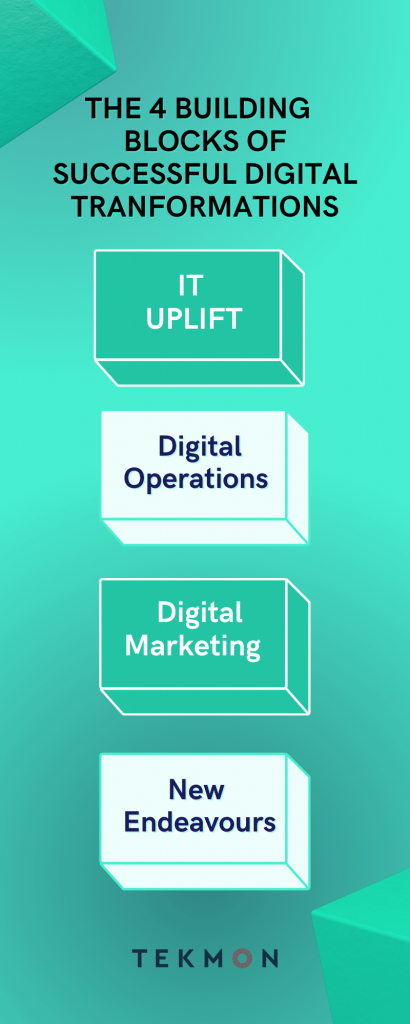Even though there has been many years of dialogue when it comes to digital transformation, it does still remain an overwhelming task for some organizations. Without a clear understanding of how to go about digital transformations and the building blocks that are involved. Organizations can often put the wrong individuals in charge and make use of the wrong resources, establishing wrong KPIs which results in a waste of time and money that can set an organizations digital transformation up for failure.
An essential part of digital transformation is to understand that it is a journey of differing goals that achieve the overall change, these goals depend on the industry and digital maturity. Having an understanding of this, will aid in articulating what direction of digital transformation an organization needs to focus on and can therefore plan accordingly. The key building blocks of digital transformation for companies, according to Harvard’s Business Review latest study are IT uplifting, digitizing operations, digital marketing and new endeavours.
However, without knowing and understanding the difference between these four building blocks of digital transformation, it can be daunting moving forward with this transformation. What could be the right resources to invest in and who can make this transformation possible. This blog can help organizations to understand the four building blocks of digital transformation and clear up any confusion in moving forward.

#1 IT Uplift
The first key building block to gather an understanding of digital transformations is to upgrade the companies IT infrastructure. This includes, mobile infrastructure, data lakes and the cloud; in essence an IT Uplift. This provides an organization with access to up-to-date ecosystems of tools that offer an increase in employee productivity, lower IT maintenance costs and overall heightened employee satisfaction.
This is usually the first step in the digital transformation journey. It requires the time and efforts of IT architects and DevOps teams, to obtain several KPIs. For example, new tools, reducing costs, improved capabilities and employee satisfaction. This is all typically down to the lead of the CIO and CTO for this building block of digital transformation.
#2 Digitizing Operations
The second more crucial building block to recognize is digitizing operations, this is the digital transformation of processes in order to optimize, simplify and rationalize operations. In order for this digitisation to take place, there is a need for more advanced technologies such as AI, 56 and IOT to result in more efficient processes, increased productivity, optimization and of-course cost reductions.
If organizations decide to not progress with these changes and digitize their operations, they can be left behind and fail to be competitive within their industry due to lack of efficient operators. Due to understanding how business works, digitizing operations often flourishes when led by a CFO or COO. It requires time, and consistent efforts but the benefits (KPIs) are savings in time, money, and less workload on individuals to solve business problems and channel those efforts in adding more value to customers.
#3 Digital Marketing
When it comes to the third building block of digital transformation which is Digital Marketing, this is the desire and need to build brand awareness to result in successfully selling online. Nonetheless, this building block differs from the others due to the fact that it focuses on digital marketing tools to interact with customers to sell. Of course, it requires various assets, for example, putting resources into sourcing clean data, computerized devices including AI to get clients and understand clients behaviours.
These digital channels are heavily dependent on AI and data analytics to capture client behaviours, so that companies can act on these behaviours before it’s too late, e.g. before a customer is likely to leave the service etc. This can help organizations establish their brand value, upsell or cross-sell and identify market leads or opportunities. As well as focusing on KPIs such as market investments and reduction in customer acquisition costs. However, most importantly, being able to generate extremely valuable data that can be used to understand potential ways to acquire future customers and better understand current.
#4 New Endeavours
Lastly, the final building block of digital transformation is to understand that embarking on this journey opens several new opportunities to establish organizations and add value. Grasping opportunities can be challenging, especially when it requires both developing innovations and digital platforms, in order to discover new avenues of growth. New endeavours can result in new business models and products, this can always open the door to growth opportunities. However, these progressions can only happen if there are innovative leaders that are open to the newness of innovative processes and access to new markets.
Final Destination
Ultimately digital transformation is a journey, it takes time and there will always be challenges that can be overcome with persistence and an open mind. There needs to be a clear starting point and goals set in place for an organisation to then strive to achieve these goals. Having the right resources and right leader, that has the understanding and willingness to learn more about technology advancements. Slowly but surely after implementation of one building block, the others naturally follow and contribute to a successful digital transformed organization, holding substantial value within their industry.
Source: https://hbr.org/2022/01/the-4-pillars-of-successful-digital-transformations

